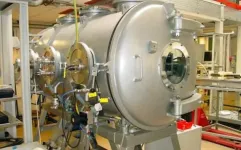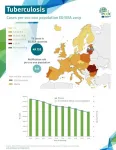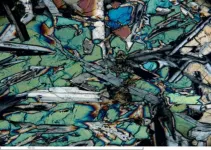Cancer screenings rebounded quickly after drop at start of pandemic
Use of mammograms and colonoscopies reached near-normal levels quickly
2021-03-22
(Press-News.org) Screenings for breast cancer and colon cancer dropped dramatically during the early months of the coronavirus pandemic, but use of the procedures returned to near-normal levels by the end of July 2020, according to a new study.
Analyzing insurance claims from more than 6 million Americans with private health coverage, researchers found that mammography rates among women aged 45 to 64 declined by 96% during March and April 2020 as compared to January and February.
Similarly, the weekly rate of colorectal cancer screenings among adults aged 45 to 64 and older declined by 95% during the period.
By the end of July 2020, however, the rate of mammograms among women had rebounded and was slightly higher than it had been before the pandemic was declared. The rate of colonoscopies also rebounded, although it remained below pre-pandemic levels, and did not rebound enough to offset initial reductions in care.
The findings are published online by the Journal of General Internal Medicine.
"These are the first findings to show that, despite real fears about the consequences of drop-off in cancer screens, health facilities figured out how to pick this back up after the initial pandemic restrictions," said Ryan McBain, the study's lead author and a policy researcher at RAND, a nonprofit research organization. "Our study shows that health systems were able to recalibrate resources and protocols in a relatively short interval to deliver these important services."
Routine cancer screening procedures such as mammography and colonoscopy -- essential for early detection and treatment of cancers -- rely primarily on office-based medical technologies.
It's been widely known that use of those procedures plummeted immediately after the coronavirus pandemic was declared in March 2020, creating concerns that the trend could delay diagnosis of cancers and as a result have adverse health consequences.
Researchers analyzed medical claims from 6.8 million commercially insured U.S. adults for the period from Jan. 15, 2020 to July 31, 2020. Medical claims data were provided by Castlight Health, a health benefits manager for employer-sponsored health insurance plans across all 50 states. The analysis was limited to those ages 45 to 64 -- target populations for cancer screening procedures prior to Medicare eligibility.
Prior to the national emergency declaration on March 13, 2020, the median weekly rate of screening mammography was 87.8 women per 10,000 beneficiaries, which declined to 6.9 in April -- a 96% drop. By the end of July, the rate of mammograms increased to 88.2 screenings per 10,000 beneficiaries.
In April 2020, colonoscopy screenings declined from 15.1 per 10,000 beneficiaries to 0.9, a 95% difference. The rate of colonoscopies rebounded to 12.6 per 10,000 beneficiaries by the end of July.
"While it is reassuring to see cancer screening rates begin to return to pre-pandemic levels, we have to ensure that people who deferred preventive services are prioritized to get their screening in a timely manner, especially if they are at higher risk of disease," said Dena M. Bravata, chief medical officer of Castlight Health.
INFORMATION:
Support for the study was provided by the National Institute on Aging.
Other authors of the study are Jonathan Cantor and Christopher M. Whaley of RAND, Anupam Jena of the Harvard Medical School and Megan F. Pera of Castlight Health.
RAND Health Care promotes healthier societies by improving health care systems in the United States and other countries.
ELSE PRESS RELEASES FROM THIS DATE:
2021-03-22
Researchers at Trinity College Dublin have been shedding light on the enigmatic "spiders from Mars", providing the first physical evidence that these unique features on the planet's surface can be formed by the sublimation of CO2 ice.
Spiders, more formally referred to as araneiforms, are strange-looking negative topography radial systems of dendritic troughs; patterns that resemble branches of a tree or fork lightning. These features, which are not found on Earth, are believed to be carved into the Martian surface by dry ice changing directly from solid to gas (sublimating) in the spring. Unlike Earth, Mars' atmosphere comprises mainly of CO2 and as temperatures decrease in winter, this deposits onto the surface as CO2 ...
2021-03-22
Optical resonators provide the foundation of modern photonics and optics. Thanks to its extreme energy confinement, the high-Q-factor optical resonator optimizes light-matter interaction and photonic device performance by enabling low-threshold laser and enhanced nonlinear harmonic generation.
Two typical structures, the photonic crystal cavity and the whispering gallery cavity, are frequently used to obtain extremely high-Q factors. However, these structures may require dimensions that are comparable to--or several times larger than--the operating wavelength. Whether there is a general way to find out all high-Q modes in a dielectric ...
2021-03-22
The tuberculosis (TB) burden in the WHO European Region as a whole is decreasing, and is down 19% overall for 2015-2019, according to the latest WHO/European Centre for Disease Prevention and Control (ECDC) report Tuberculosis surveillance and monitoring in Europe 2021 (2019 data).
Regional TB mortality has gone down, declining by 9.4% between 2018 and 2019. This is notably higher than the average global decline in TB mortality (3.7%) and enough to have reached the End TB Strategy milestone of a 35% reduction by 2020 compared to 2015.
However, TB is second only to COVID-19 as an infectious disease that kills, and drug resistance is a major concern. There are also worrying indications that the COVID-19 pandemic may stall progress or cause significant setbacks in the fight against TB.
The ...
2021-03-22
Developing a standardized drying protocol for goldenseal could lead to more predictable health applications and outcomes by preserving the alkaloids found in the plant, which is native to Appalachia, according to Penn State researchers, who conducted a new study of the medicinal forest herb.
The roots and rhizomes of goldenseal -- Hydrastis canadensis -- have been used for hundreds of years as a source of antimicrobials and compounds to treat intestinal ailments, noted study co-author Eric Burkhart, associate teaching professor, ecosystem science ...
2021-03-22
Antibody injections are a highly desirable treatment for people with chronic diseases such as cancer, psoriasis, Crohn's disease and arthritis. And recently, antibodies have been in the news as a promising treatment for severe cases of COVID-19.
But the costly, time-consuming manufacturing process to produce antibodies prevents these treatments from being accessible to most patients.
Andrew Zydney, Bayard D. Kunkle Chair and professor of chemical engineering at Penn State, has identified a new method to manufacture antibodies, which could drive down the production cost. His research results were recently published in Biotechnology Progress.
"If you look at the top 10 best-selling medications, by annual sales, eight ...
2021-03-22
A new type of rock created during large and exceptionally hot volcanic eruptions has been discovered beneath the Pacific Ocean.
An international team of researchers including the University of Leeds unearthed the previously unknown form of basalt after drilling through the Pacific ocean floor.
The discovery suggests that ocean floor eruptions sourced in the Earth's mantle were even hotter and more voluminous than previously thought. Report co-author is Dr Ivan Savov, of Leeds' Institute of Geophysics and Tectonics, in the university's School of Earth and Environment.
He said: "In an era when we rightly admire discoveries made through space exploration, our findings show there are still many discoveries still to make on our ...
2021-03-22
The increasing frequency and severity of extreme weather events like droughts and floods have taken a toll on the midwestern U.S. in recent years, putting a major strain on the region's farmers. From 2001 to 2010, the Federal Crop Insurance Program, a government program created to protect farmers from crop loss, covered $4.1 billion in damages; in 2011 alone, the program paid out $10.8 billion.
With the largest U.S. crop -- corn -- conservatively estimated to drop in yield anywhere from 20 to 80 percent due to extreme weather exacerbated by climate change, insurance claims may skyrocket to levels that may not be sustainable. But researchers from the Yale School of the Environment (YSE) found that by considering soil properties when determining insurance premiums ...
2021-03-22
Less than a decade after unveiling the "Map of Life," a global database that marks the distribution of known species across the planet, Yale researchers have launched an even more ambitious and perhaps important project -- creating a map of where life has yet to be discovered.
For Walter Jetz, a professor of ecology and evolutionary biology at Yale who spearheaded the Map of Life project, the new effort is a moral imperative that can help support biodiversity discovery and preservation around the world.
"At the current pace of global environmental change, there is no doubt that many species will go extinct before we have ever learned ...
2021-03-22
Efficient conversion of CO2 is strategically significant for alleviating the energy crisis and achieving the goal of carbon neutrality. One promising conversion route is the hydrogenation of CO2 to methanol using a renewable energy-based "green hydrogen" source.
Traditional metal oxide catalysts for this reaction typically require a high temperature (>300 oC), which tends to promote undesired reverse water-gas shift (RWGS) side reactions, thus producing a large amount of CO as the by-product.
Introduction of transition metal components onto metal oxides can promote the activation of H2, thereby reducing the reaction temperature, but this also facilitates excessive hydrogenation of CO2 to CH4, leading to lowered methanol selectivity. Further improvement of the performance ...
2021-03-22
Physicians across the country have analyzed the emerging scientific data about the long-term effects of COVID-19, creating an initial knowledge base about the clinical experiences of so-called "long-haulers" - patients with COVID-19 who experience prolonged symptoms and/or the emergence of new ones well after the initial viral infection has resolved. A comprehensive review published today in Nature Medicine offers an initial glimpse of the multi-organ effects of long-term COVID-19 and suggests a framework for the care of COVID-19 long-haulers through dedicated, multidisciplinary clinics.
"It was important to respond to our patients' concerns and pay close attention to the symptoms they were experiencing beyond the acute phase of COVID-19," said Kartik Sehgal, MD, a lead ...
LAST 30 PRESS RELEASES:
[Press-News.org] Cancer screenings rebounded quickly after drop at start of pandemic
Use of mammograms and colonoscopies reached near-normal levels quickly






